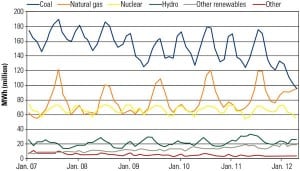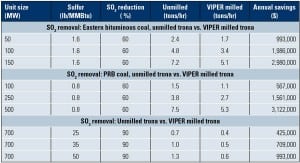In This Issue
-
O&M
Coal Could Regain Ground from Gas as Summer Demand Ramps Up
Natural gas-fired generation enjoyed a competitive advantage through this past winter and spring as historically low prices for the commodity combined with mild weather and relatively light demand to turn the dispatch stack on its head and favor gas over coal. That advantage is narrowing as summer demand approaches. A senior market analyst with Bentek Energy expects coal-fired generation to be advantaged at least until the fall shoulder season.
-
Commentary
Changing of the Guard
Preliminary data published by the Energy Information Administration shows that the amounts of power generated by coal and natural gas in April were virtually equal. Was this a one-time event or an indicator of a future trend?
-
Commentary
Stopping the EPA: The Long Game
The D.C. Court of Appeals recently declined to examine the science behind the EPA’s Endangerment Finding that is the foundation beneath the its greenhouse gas rules. The next step is to challenge the EPA’s science.
-
Commentary
Green Jobs Count: Fewer Than Before, Sillier Than Ever
The Bureau of Labor Statistics has released another report on green jobs. According to the BLS, an oil industry lobbyist could be considered as having a green job. The report’s definitions still lack common sense.
-
O&M
Why Coal Plants Retire: Power Market Fundamentals as of 2012
Announcements about coal plant retirements have become commonplace. Are new EPA rules completely to blame, or are there other power market pressures at play?
-
Coal
Design Features of Advanced Ultrasupercritical Plants, Part III
Advanced ultrasupercritical (A-USC) is a term used to designate a coal-fired power plant design with the inlet steam temperature to the turbine at 700C to 760C. In the first two parts of this three-part report, we introduced the A-USC boiler and the metallurgical advancements required for the A-USC boiler to operate at such high temperatures. This final report explores the A-USC boiler’s unique design challenges.
-
O&M
In-Line Sorbent Milling Improves Dry Sorbent Injection Performance
Complying with air emissions rules doesn’t always require construction of a scrubber or SCR. Finely ground trona has proven to be very successful at economically removing SO3, SO2, and HCl from stack gases.
-
Coal
Federal Court Rejects Challenges to EPA Industrial, Automotive GHG Rules
A three-judge panel of the U.S. Court of Appeals for the D.C. Circuit on June 26 ruled that the U.S. Environmental Protection Agency (EPA) was "unambiguously correct" in its interpretation of the Clean Air Act (CAA) to regulate carbon dioxide emissions. The federal agency’s endangerment finding that greenhouse gases (GHG), including carbon dioxide, are a threat to public health and welfare, and its decision to set limits for industrial and automotive emissions of GHGs, was "neither arbitrary nor capricious," the court ruled. The court, however, found that it lacked jurisdiction to review the timing and scope of the GHG rules that affect larger stationary sources, including new coal-fired power plants.
-
Coal
EPA Proposes Clean Air Standards for PM2.5
In response to a court order, the U.S. Environmental Protection Agency (EPA) proposed updates on June 15 to its national air quality standards for harmful fine particle pollution, including soot (known as PM2.5). The agency says that 99% of U.S. counties are projected to meet proposed standards without any additional actions.





